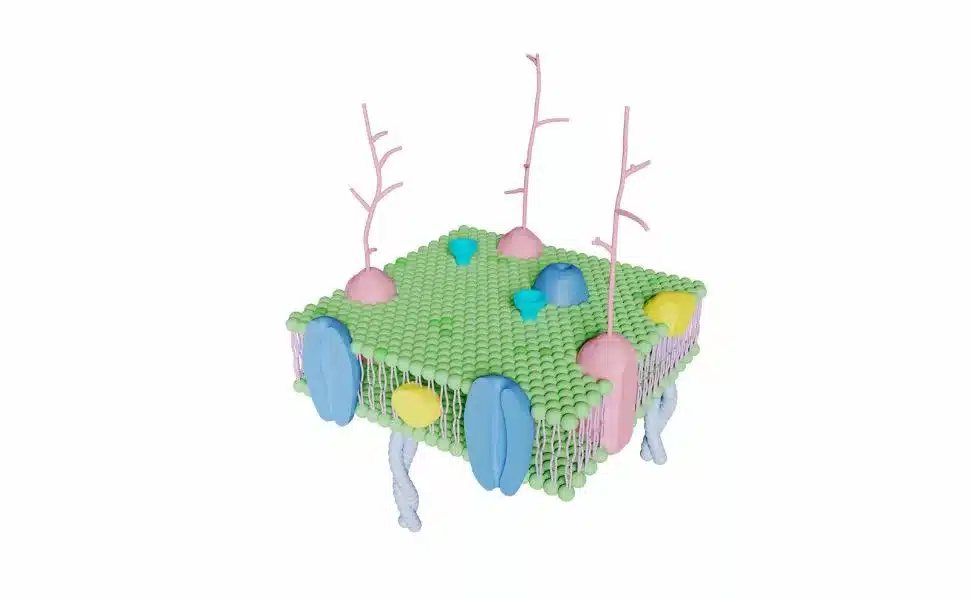In this article we will discuss the relationship between DHA and phosphatidylserine and its importance for brain and eye health. We make special mention of the importance of DHA during pregnancy, as it is particularly important during fetal development and the first years of a baby’s life. DHA has also been shown to be essential in the prevention of cognitive impairment and studies indicate its positive effect in reducing the symptoms of attention deficit hyperactivity disorder (ADHD). Plant phosphatidylserine is a relatively recent nutrient, since most studies have been based on bovine brain phosphatidylserine. In this article we will discuss the differences between the two types of phosphatidylserine and the latest clinical studies with vegetable phosphatidylserine.
What is DHA?
The name DHA or docosahexaenoic acid is a type of polyunsaturated fatty acid of the omega-3 series(omega-3 PUFA), which is found naturally in seafood, such as fish (especially cold-water fatty fish, such as salmon, mackerel, tuna, herring, and sardines) and shellfish. Nuts and seeds, too, possess omega-3 PUFAs, however, these are composed mostly of α-linolenic acid (ALA). ALA must be converted to DHA and EPA (eicosapentaenoic acid, another important omega-3 PUFA) before your body can use it for more than just energy production. However, this conversion process is inefficient in humans. Only a small percentage of ALA is converted to EPA, and even less to DHA.
What is phosphatidylserine?
Phosphatidylserine is an essential phospholipid, more precisely a glycerophospholipid, consisting of structural units composed of a glycerol molecule linked to two fatty acid units (through an ester bond), and a phosphorylated serine unit (through a phosphoester bond).
Phospholipids are amphipathic lipids (fats), found in all plant and animal cell membranes, arranged as lipid bilayers. Their amphipathic property allows them to have hydrophilic and hydrophobic regions in the same molecule, which is essential for maintaining the integrity of cell membranes.
Phosphatidylserine is distributed throughout the body, since all the cells of our organism need it equally, playing a fundamental role in the structural stability of cell membranes. Although it is distributed throughout the body, it is found in greater quantities in the cells of organs with high metabolic activity, such as the lungs, heart, liver, skeletal muscle and, above all, in the cerebral cortex (or gray matter). Due to its anionic character, phosphatidylserine binds to various proteins and is involved in many biological processes. In the brain, phosphatidylserine influences the conduction of nerve impulses (neurotransmission) and the creation of new synaptic connections 1.
Neuronal plasticity, so named by Ramón y Cajal in 1894, is the ability of neurons to change or create new synaptic connections in response to experience and learning.
What is the relationship between DHA and phosphatidylserine in the brain?
DHA is the most important omega-3 PUFA in the brain, as both eicosapentaenoic acid (EPA) and α-linolenic acid (ALA) are present in very small amounts 2. DHA constitutes more than 90% of the brain’s omega-3 PUFA and 10% to 20% of its total lipids (fats), being present mainly in the gray matter (or gray matter), in the form of phospholipids such as phosphatidylserine and phosphatidylethanolamine, and in smaller amounts as phosphatidylcholine 3, 4. In the case of phosphatidylserine, DHA represents 30% of all the fatty acids of this phospholipid5. DHA is also relatively abundant in the retina, constituting approximately 50% of all the fatty acids in photoreceptor neurons 6, 7.
What makes DHA so important for the brain?
DHA is known to readily cross the blood-brain barrier, which may help explain its high presence in neuronal membrane phospholipids such as phosphatidylserine 2. As the most polyunsaturated fatty acid of the omega-3 family, with 22 carbons and 6 cis-configuration double bonds, DHA has a “multi-curved” structure due to its cis-configuration double bonds, which prevents the structural units of the phospholipids that make up the lipid bilayer from being tightly packed. This feature confers to the cell membrane of neurons a greater fluidity, flexibility and permeability, which is very necessary for a multitude of vital physiological processes 8, 9, such as neurotransmitter release, photoreceptor function, signal transduction, differentiation and neuronal growth 10.
DHA in infancy and early life
In fact, DHA is known to play a preponderant role in the formation of neurons (neurogenesis) and synapses (synaptogenesis), particularly in fetal development and during the first two years of life 11. Consequently, the DHA nutritional status of the mother pregestational, gestational and during lactation represents a critical stage for the brain and visual development of the child 12, 13. Several studies correlate high levels of DHA in the mother’s blood and breast milk with increased brain and visual development of her child 14. A multivariate statistical analysis showed that a deficient intake of DHA during pregnancy increases the risk of reduced visual acuity 15. These findings indicate that supplementation with DHA during pregnancy and lactation may be very important to ensure an adequate intake of DHA in the infant, with the consequent achievement of better visual and neurological development of the child 15.
DHA and ADHD
DHA intake also appears to be important for the prevention of attention deficit hyperactivity disorder (ADHD). Several clinical studies have verified that children with ADHD usually present low levels of DHA 16-18 and dietary supplementation with this nutrient seems to induce improvements in symptoms 16, 17. The beneficial effect of DHA will be related to its action on the fluidity of neuronal membranes, fundamental for the normal flow of neurotransmitters such as dopamine and serotonin, which are affected in ADHD carriers 19. In fact, environmental studies have identified the deficit in DHA intake by the mother pregestational, gestational and during lactation, as an important non-genetic risk factor for ADHD 12, 13, 20.
DHA and cognitive impairment
On the basis of several scientific studies, the protective effect of DHA and EPA PUFAs on nerve cells has been demonstrated in both human 21 and animal studies 22 and their mechanisms of action have been further investigated in in vitro cellular models23. For example, in an interesting study with rats with diabetes mellitus, supplementation with DHA-concentrated omega-3 PUFA prevented anatomofunctional deterioration in neurons, a characteristic picture of diabetic neuropathy 24, and also reduced oxidative damage and learning disabilities(Morris water maze model) in rats with traumatic brain injury 25. 25 In another study, rats fed a DHA-poor diet showed impaired learning and cognitive function, effects that were reversed when DHA supplementation was restored .
Considering the importance of DHA for normal brain development, many researchers have wondered whether DHA might have a relationship with Alzheimer’s disease. In fact, research has shown that DHA is found in reduced levels in the brains of people who have died of Alzheimer’s disease 27. It has been postulated that neuroprotectin D-1 (NPD-1), a substance that is synthesized in our body from DHA, could be responsible for its neuroprotective properties. According to some studies, NPD-1 has the capacity to decrease the generation of proinflammatory cytokines and to reduce the formation of amyloid deposits in the brain 28.
It is currently postulated that the omega-3 PUFAs DHA and EPA can be used as an integral part of the treatment of multiple neuropathologies, in addition to diabetic neuropathy and Alzheimer’s disease, including Parkinson’s disease 29, 30, multiple sclerosis 31 and depression 32.
According to the Scientific Panel of the European Food Safety Agency (EFSA), docosahexaenoic acid (DHA) contributes to the maintenance of normal vision and normal brain function. The beneficial effect is obtained with a daily intake of 250 mg of DHA 33. Nutribiolite DHA-PS provides 500 mg of DHA per daily dose.
What makes phosphatidylserine so important for the brain?
The concentration of phosphatidylserine in our body decreases as we age, mainly after the age of 50, and this decrease is related to a decline in cognitive abilities 34. Although the body is able to synthesize phosphatidylserine from other phospholipids (phosphatidylcholine and phosphatidylethanolamine), this process is complex and has a high energy expenditure when compared to direct incorporation from the diet 35. Unfortunately, phosphatidylserine is not abundantly present in most foods. Plants provide a very low amount of this nutrient and foods of animal origin, with the exception of brain, have modest amounts. For this reason, supplementation has been a widely used resource to regulate phosphatidylserine levels in the body. It easily crosses the blood-brain barrier and reaches significant concentrations in the brain 4.
Phosphatidylserine of vegetable origin
Perhaps one of the problems in the supplementation of phosphatidylserine is that, until now, it was extracted from the cortex of the bovine brain, an organ extremely rich in this and other phospholipids. In fact, many scientific studies that have verified the beneficial effects of phosphatidylserine supplementation have been carried out with animal phosphatidylserine from bovine brain. However, due to concerns with spongiform encephalopathy (popularly known as mad cow disease), its use in food supplements and foodstuffs was banned in the European Union, and only its use in pharmaceuticals is allowed. The particularity of bovine brain phosphatidylserine is the presence of DHA in its structure. As an alternative, food supplement and vitamin laboratories use vegetable phosphatidylserine. This is much safer and is mostly obtained from soy or sunflower lecithin. The difference with respect to animal phosphatidylserine is that plant phosphatidylserine does not have DHA incorporated into its structure. Instead, it contains oleic and linoleic acid units.
The exact mechanism of nootropic action of vegetable phosphatidylserine has not yet been deciphered, but animal studies indicate that its frequent consumption increases brain glucose metabolism 36 and increases the number of receptors for brain neurotransmitters such as acetylcholine 37, as occurs with bovine brain phosphatidylserine.
Although there are not yet many published clinical studies on supplementation with vegetable phosphatidylserine, we can consider that the evidence is sufficient to justify its incorporation in dietary supplements for brain nutrition. In fact, several clinical studies show the benefits of its supplementation in the improvement of symptoms of age-related memory impairment (ADHD) 38-43, the reduction of symptoms of attention deficit hyperactivity disorder (ADHD) 44, 45, depression in the elderly 46, 47 and fatigue in athletes 48-50.
At the moment, food regulations do not authorize the use of health properties on vegetable phosphatidylserine. If you are interested in introducing this nutrient into your supplementation plan, we suggest that you consult the scientific literature for more information on this nutrient.
Vegetable Phosphatidylserine and Cognitive Impairment
A group of researchers from the Department of Geriatrics at Kaplan Hospital in Israel was, in 1995, the first to study the effect of supplementation with vegetable phosphatidylserine (from soybeans) in elderly people with age-related memory impairment (AMD). Subsequent studies have corroborated the relevance of this supplementation in the elderly, finding a direct relationship between its intake and the improvement of cognitive abilities (Schreiber, S. et al. 39, Crook T.H. 40, Asano et al.41, Kato-Kataoka et al. 42, Richter et al. 43). The amounts of phosphatidylserine used in these clinical studies ranged from 100 mg to 300 mg per day.
Of note is the double-blind clinical trial led by Kato-Kataoka et al.42 from the Central Yakult Institute of Kunitachi in Tokyo, conducted in 2010 with 78 Japanese elderly people with AMD. The researchers studied the effect of supplementation of 100 and 300 mg/day of vegetable phosphatidylserine on the improvement of AMD symptoms, having observed a significant positive effect on cognitive performance, especially in the subgroup of subjects who presented very low scores on cognitive assessment tests before starting treatment. Another interesting observation from this study was that both 100 mg and 300 mg supplementation produced the same results.
Vegetable phosphatidylserine and ADHD
Interest in phosphatidylserine supplementation in children with attention deficit hyperactivity disorder (ADHD) is due to the fact that children with ADHD often have low levels of phosphatidylserine in brain areas such as the basal ganglia and prefrontal cortex 51, 52, which are targeted by ADHD treatment medications 53.
In 2006, researchers at Okayama University in Japan published a pilot study to evaluate the possible beneficial effects of plant phosphatidylserine supplementation in a group of 15 children with attention deficit hyperactivity disorder (ADHD), aged 6 to 12 years 44. The researchers observed a significant improvement in ADHD symptoms after supplementation of 200 mg of plant phosphatidylserine for 2 months. As this was a pilot study, it lacked a control group, and would simply serve as a basis for a subsequent clinical study. Finally, in 2013, the researchers published the results of a randomized, double-blind, placebo-controlled clinical trial with 36 children aged 4 to 14 years with ADD. In this study, vegetable phosphatidylserine supplementation was reduced to a daily intake of 100 mg, which was sufficient to produce significant improvements in ADHD symptoms, such as improved short-term auditory memory, working memory and mental performance to visual stimuli 45.
Vegetable phosphatidylserine and omega-3 PUFAs
Due to their effects on brain biochemistry, it has been suggested that supplementation with plant phosphatidylserine and DHA could help manage the symptoms of cognitive decline that occur during normal or pathological aging. Indeed, several meta-analyses of clinical studies in elderly people with moderate mental deterioration are described in the literature, indicating that prolonged administration of animal or vegetable phosphatidylserine 46 and omega-3 PUFA rich in DHA 54 could improve cognitive and behavioral parameters, in particular attention, memory, sleep disturbances and depressive symptoms 55.
The strict relationship between DHA intake and the natural production of phosphatidylserine is noteworthy. Animal studies have revealed that a diet rich in DHA stimulates the production of phosphatidylserine in neuronal cells, in which DHA is incorporated into their structure 56, 57. As mentioned above, the presence of DHA in the phospholipid bilayers of phosphatidylserine in the membranes of neuronal cells is very necessary for their correct functioning.
If each of these nutrients alone can help control the symptoms of cognitive impairment, a combination of both would be an advantageous option, especially considering the relationship between DHA and phosphatidylserine in the brain.
As an example, we highlight a study conducted in 2015 by researchers at the Mie University School of Medicine in Japan, in which they studied the effect of combined supplementation of 100 mg of plant phosphatidylserine with 119 mg of DHA and 70 mg of EPA on improving symptoms of depression in the elderly 47.The study participants were people over 65 years of age who had not previously responded to treatment with antidepressants. After 12 weeks of supplementation, the Hamilton depression scale (which measures the level of depression) was significantly better in the supplemented subjects. A stabilization in salivary cortisol levels and circadian rhythm was also observed in these individuals.
DHA and phosphatidylserine: two better than one
Nutribiolite DHA-PS is an excellent alternative for your combined DHA and phosphatidylserine supplementation. Each recommended daily dose provides 500 mg of DHA and 100 mg of EPA from sustainable Omegatex® sources, and 100 mg of phosphatidylserine from Sharp-PS Green® sunflower lecithin (soy-free), in two easy-to-take mini softgels.
This product has no contraindications and can be taken by pregnant women or women who intend to become pregnant. It is an excellent way to ensure a daily intake of DHA, which is important for normal brain and vision development in infants 33, 34. The EFSA scientific panel also noted that the benefit of ingesting this nutrient also applies to all ages 33, so we recommend it for the adult population and especially for the elderly.
➪ DHA-PS omega-3 fatty acids DHA and EPA are from the prestigious Spanish brand Omegatex®, from fish oil obtained from sustainable sources and with pharmaceutical quality. No solvents, high temperatures or aggressive conditions are used during the purification processes. The product is odorless since the elimination of odor residues is done through a patented method exclusive to Omegatex®.
➪ DHA-PS phosphatidylserine is from the renowned Sharp-PS Green® brand, and is obtained from sunflower seeds from sustainable sources in Europe. It is therefore a non-GMO and soy-free product, completely safe for people allergic to this ingredient.
Conclusion
DHA and phosphatidylserine are fundamental constituents of the cell membranes of neurons of the central nervous system and photoreceptors of the retina. These two nutrients are closely related, and the flexibility and fluidity of neuronal membranes depend on them. This characteristic is necessary for a multitude of vital physiological processes, such as, for example, allowing membrane proteins and neurotransmitters to have the mobility required for their functions. The lack of these nutrients during the early stages of life is related to neurological problems in children and a not insignificant percentage continues into adulthood. Supplementation in the adult phase has allowed to observe improvements in the symptoms, being particularly important in the third age.
- Ma, X., et al., Phosphatidylserine, inflammation, and central nervous system diseases. Frontiers in Aging Neuroscience, 2022. 14.
- Dyall, S.C., Long-chain omega-3 fatty acids and the brain: a review of the independent and shared effects of EPA, DPA and DHA. Front Aging Neurosci, 2015. 7: p. 52.
- Weiser, M.J., C.M. Butt, and M.H. Mohajeri, Docosahexaenoic Acid and Cognition throughout the Lifespan. Nutrients, 2016. 8(2): p. 99-99.
- Kim, H.Y., B.X. Huang, and A.A. Spector, Phosphatidylserine in the brain: metabolism and function. Prog Lipid Res, 2014. 56: p. 1-18.
- Mozzi, R., S. Buratta, and G. Goracci, Metabolism and Functions of Phosphatidylserine in Mammalian Brain. Neurochemical research, 2003. 28: p. 195-214.
- Fliesler, S.J. and R.E. Anderson, Chemistry and metabolism of lipids in the vertebrate retina. Prog Lipid Res, 1983. 22(2): p. 79-131.
- Zemski Berry, K.A., et al., Spatial organization of lipids in the human retina and optic nerve by MALDI imaging mass spectrometry. J Lipid Res, 2014. 55(3): p. 504-15.
- Tanaka, K., et al., Effects of docosahexaenoic Acid on neurotransmission. Biomolecules & therapeutics, 2012. 20(2): p. 152-157.
- Jin, J., et al., High Sn-2 Docosahexaenoic Acid Lipids for Brain Benefits, and Their Enzymatic Syntheses: A Review. Engineering, 2020. 6(4): p. 424-431.
- Alfonso, V. and V. Rodrigo, Omega-3 Docosahexaenoic Acid (DHA) and Mood Disorders: Why and How to Provide Supplementation?, in Mood Disorders, K. Nese, Editor. 2013, IntechOpen: Rijeka. p. Ch. 10.
- Campoy, C., et al., Omega 3 fatty acids on child growth, visual acuity and neurodevelopment. Br J Nutr, 2012. 107 Suppl 2: p. S85-106.
- McCann, J.C. and B.N. Ames, Is docosahexaenoic acid, an n-3 long-chain polyunsaturated fatty acid, required for development of normal brain function? An overview of evidence from cognitive and behavioral tests in humans and animals. Am J Clin Nutr, 2005. 82(2): p. 281-95.
- Innis, S.M., Perinatal biochemistry and physiology of long-chain polyunsaturated fatty acids. J Pediatr, 2003. 143(4 Suppl): p. S1-8.
- Lauritzen, L., et al., DHA Effects in Brain Development and Function. Nutrients, 2016. 8(1): p. 6.
- Makrides, M., M.A. Neumann, and R.A. Gibson, Perinatal characteristics may influence the outcome of visual acuity. Lipids, 2001. 36(9): p. 897-900.
- Hawkey, E. and J.T. Nigg, Omega-3 fatty acid and ADHD: blood level analysis and meta-analytic extension of supplementation trials. Clin Psychol Rev, 2014. 34(6): p. 496-505.
- Richardson, A.J., Omega-3 fatty acids in ADHD and related neurodevelopmental disorders. Int Rev Psychiatry, 2006. 18(2): p. 155-72.
- Fuentes-Albero, M., M.I. Martinez-Martinez, and O. Cauli, Omega-3 Long-Chain Polyunsaturated Fatty Acids Intake in Children with Attention Deficit and Hyperactivity Disorder. Brain Sci, 2019. 9(5).
- National Institutes of Health Consensus Development Conference Statement: diagnosis and treatment of attention-deficit/hyperactivity disorder (ADHD). J Am Acad Child Adolesc Psychiatry, 2000. 39(2): p. 182-93.
- Braun, J.M., et al., Exposures to environmental toxicants and attention deficit hyperactivity disorder in U.S. children. Environ Health Perspect, 2006. 114(12): p. 1904-9.
- Mozaffarian, D., et al., Cardiac Benefits of Fish Consumption May Depend on the Type of Fish Meal Consumed. Circulation, 2003. 107(10): p. 1372-1377.
- Lauritzen, I., et al., Polyunsaturated fatty acids are potent neuroprotectors. The EMBO journal, 2000. 19(8): p. 1784-1793.
- Högyes, E., et al., Neuroprotective effect of developmental docosahexaenoic acid supplement against excitotoxic brain damage in infant rats. Neuroscience, 2003. 119(4): p. 999-1012.
- Mayurasakorn, K., et al., Docosahexaenoic acid: brain accretion and roles in neuroprotection after brain hypoxia and ischemia. Curr Opin Clin Nutr Metab Care, 2011. 14(2): p. 158-67.
- Gerbi, A., et al., Fish Oil Supplementation Prevents Diabetes-Induced Nerve Conduction Velocity and Neuroanatomical Changes in Rats. The Journal of Nutrition, 1999. 129(1): p. 207-213.
- Wu, A., Z. Ying, and F. Gomez-Pinilla, Dietary omega-3 fatty acids normalize BDNF levels, reduce oxidative damage, and counteract learning disability after traumatic brain injury in rats. J Neurotrauma, 2004. 21(10): p. 1457-67.
- Söderberg, M., et al., Fatty acid composition of brain phospholipids in aging and in Alzheimer’s disease. Lipids, 1991. 26(6): p. 421-5.
- Bazan, N.G., Neuroprotectin D1 (NPD1): a DHA-derived mediator that protects brain and retina against cell injury-induced oxidative stress. Brain Pathol, 2005. 15(2): p. 159-66.
- Bazan, N.G., Cell survival matters: docosahexaenoic acid signaling, neuroprotection and photoreceptors. Trends Neurosci, 2006. 29(5): p. 263-71.
- Calon, F. and G. Cole, Neuroprotective action of omega-3 polyunsaturated fatty acids against neurodegenerative diseases: evidence from animal studies. Prostaglandins Leukot Essent Fatty Acids, 2007. 77(5-6): p. 287-93.
- Mehta, L.R., R.H. Dworkin, and S.R. Schwid, Polyunsaturated fatty acids and their potential therapeutic role in multiple sclerosis. Nat Clin Pract Neurol, 2009. 5(2): p. 82-92.
- Rondanelli, M., et al., Long chain omega 3 polyunsaturated fatty acids supplementation in the treatment of elderly depression: effects on depressive symptoms, on phospholipids fatty acids profile and on health-related quality of life. J Nutr Health Aging, 2011. 15(1): p. 37-44.
- COMMISSION REGULATION (EU) No 432/2012 of 16 May 2012 establishing a list of permitted health claims made on foods, other than those referring to the reduction of disease risk and to children’s development and health (Updating Regulation (EC) No 1924/2006), in Official Journal of the European Union, European D.O.d.l.U., Editor. 2012.
- Berdonces, J.L., Phosphatidylserine.
- Glade, M.J. and K. Smith, Phosphatidylserine and the human brain. Nutrition, 2015. 31(6): p. 781-786.
- Sakai, M., H. Yamatoya, and S. Kudo, Pharmacological effects of phosphatidylserine enzymatically synthesized from soybean lecithin on brain functions in rodents. J Nutr Sci Vitaminol (Tokyo), 1996. 42(1): p. 47-54.
- Yamatoya, H., M. Sakai, and S. Kudo, The effects of soybean transphosphatidylated phosphatidylserine on cholinergic synaptic functions of mice. Jpn J Pharmacol, 2000. 84(1): p. 93-6.
- J., G., et al., The Effect of Plant Phosphatidylserine on Age Associated Memory Impairment and Mood in the Functioning Elderly. The Geriatric Institute for Education and Research, and Department of Geriatrics, Kaplan Hospital, Rehovot, Israel, 1995.
- Schreiber, S., et al., An open trial of plant-source derived phosphatydilserine for treatment of age-related cognitive decline. Isr J Psychiatry Relat Sci, 2000. 37(4): p. 302-7.
- Crook, T.H., Treatment of age-related cognitive decline: effects of phosphatidylserine. Anti-Aging Medical Therapeutics, ed. R.M. Katz and R. Goldman. Vol. II. 1998, Marina del Rey, Carfornia: Health Quest Publications.
- Asano, T., et al., The effect of soybean derived phosphatidylserine on the cognitive function of the elderly. The Japanese Journal of Nutrition and Dietetics, 2005. 24: p. 165-170.
- Kato-Kataoka, A., et al., Soybean-derived phosphatidylserine improves memory function of the elderly Japanese subjects with memory complaints. J Clin Biochem Nutr, 2010. 47(3): p. 246-55.
- Richter, Y., et al., The effect of soybean-derived phosphatidylserine on cognitive performance in elderly with subjective memory complaints: a pilot study. Clinical interventions in aging, 2013. 8: p. 557-563.
- Hirayama, S., M. Y., and R. R., Effect of phosphatidylserine administration on symptoms of attention-deficit/hyperactivity disorder in children. Agro Food Ind. Hi Tech. 2006. 17: p. 32-36.
- Hirayama, S., et al., The effect of phosphatidylserine administration on memory and symptoms of attention-deficit hyperactivity disorder: a randomised, double-blind, placebo-controlled clinical trial. Journal of Human Nutrition and Dietetics, 2014. 27(s2): p. 284-291.
- Kang Eun, Y., et al., Effect of phosphatidylserine on cognitive function in the elderly: A systematic review and meta-analysis. Korean Journal of Food Science and Technology, 2022. 54(1): p. 52-58.
- Komori, T., The Effects of Phosphatidylserine and Omega-3 Fatty Acid-Containing Supplement on Late Life Depression. Mental illness, 2015. 7(1): p. 5647-5647.
- Kingsley, M.I., et al., Phosphatidylserine supplementation and recovery following downhill running. Med Sci Sports Exerc, 2006. 38(9): p. 1617-25.
- Kingsley, M., Effects of phosphatidylserine supplementation on exercising humans. Sports Med, 2006. 36(8): p. 657-69.
- Monteleone, P., et al., Effects of phosphatidylserine on the neuroendocrine response to physical stress in humans. Neuroendocrinology, 1990. 52(3): p. 243-8.
- Spahis, S., et al., Lipid profile, fatty acid composition and pro- and anti-oxidant status in pediatric patients with attention-deficit/hyperactivity disorder. Prostaglandins Leukot Essent Fatty Acids, 2008. 79(1-2): p. 47-53.
- Stanley, J.A., et al., Regionally specific alterations in membrane phospholipids in children with ADHD: An in vivo 31P spectroscopy study. Psychiatry Res, 2006. 148(2-3): p. 217-21.
- Czerniak, S.M., et al., Areas of the brain modulated by single-dose methylphenidate treatment in youth with ADHD during task-based fMRI: a systematic review. Harv Rev Psychiatry, 2013. 21(3): p. 151-62.
- Liao, Y., et al., Efficacy of omega-3 PUFAs in depression: A meta-analysis. Translational Psychiatry, 2019. 9(1): p. 190.
- Maggioni, M., et al., Effects of phosphatidylserine therapy in geriatric patients with depressive disorders. Acta Psychiatr Scand, 1990. 81(3): p. 265-70.
- Kim, H.Y., B.X. Huang, and A.A. Spector, Molecular and Signaling Mechanisms for Docosahexaenoic Acid-Derived Neurodevelopment and Neuroprotection. Int J Mol Sci, 2022. 23(9).
- Kim, H.-Y., M. Akbar, and Y.-S. Kim, Phosphatidylserine-dependent neuroprotective signaling promoted by docosahexaenoic acid. Prostaglandins, leukotrienes, and essential fatty acids, 2010. 82(4-6): p. 165-172.



















